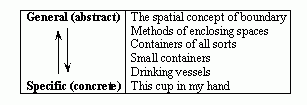CLASS
D
PHASE
Idea generation
DESCRIPTION
Switching to and fro between different levels of abstraction to create ideas is often known as ‘laddering’. The sequence below is a ‘ladder’ of concepts in which the items lower down are all members or sub-sets of the ones higher up so that you move between the abstract and the concrete:

-
Define the existing idea to start from: ‘This cup in my hand’.
-
Ladder up: What wider categories could it is an example of? ‘A drinking vessel; something made of china; a present from my daughter, things on my desk…’ Say you decide to build on ‘A drinking vessel’ then ladder up again. What could it be an example of? ‘A smaller container; a domestic utensil; something for holding fluids…’
-
Ladder down again: Put together a list for ‘A small container’ but this time laddering down; give some examples of ‘small containers’. ‘Boxes, bottles, envelopes, buckets, bags…’ Give some examples of ‘bottles’: ‘Soft-drink bottles, gas bottles, ink bottles, antique bottles, bottles with message in them… Give some examples of ‘soft-drink bottles’: ‘Plastic Coke bottles, milk bottles, great big bottles of mineral water, posh soft-drink bottles made to look on in the fridge; the huge, medium and small ones on the super-market shelves; ones labelled in Japanese; ones used for primary school constructions…’
-
Ladder up again: Now make a list for ‘milk-bottles’ by laddering up. What are they examples of? ‘Recyclable-containers’. What are the ‘recyclable containers’ examples of? ‘Waste reduction; green policies; potential resources’, etc.,
-
Generally, laddering up towards the general lets you to expand out into new areas. Laddering down allows you to focus down onto definite parts of these new areas. Alternating between the two helps you to investigate a wider territory. Laddering up is typically more difficult than laddering down. If stuck, try the following:
-
‘Why? /So what?’: continually asking ‘Why?’ normally results in laddering up; repeatedly asking ‘So what?’ tends to ladder down.
-
‘Construct-triad’ method: Choose any three ideas you already have and find some way in which two of the three go together, but the third is different. For instance, in a productivity problem, three ideas might be:
- Pay employees more
- Reduce waste
- Improve management
One possible distinction might be a technical vs. human
one: reduce waste is technical; pay employees more and improve management
are human. You could now ladder up from reduce waste either to technical
or to non-human solutions (or vice-versa for the other two ideas).
[Source:
www.mycoted.com ]
REFERENCES